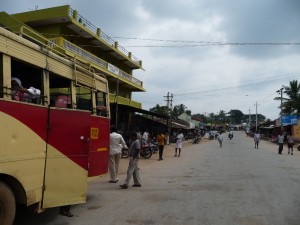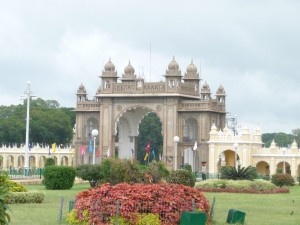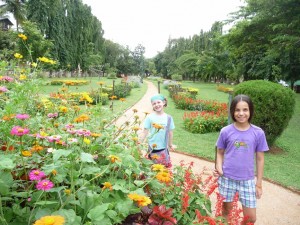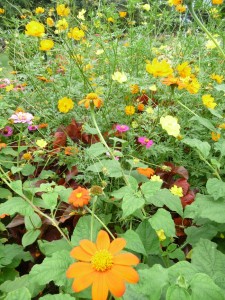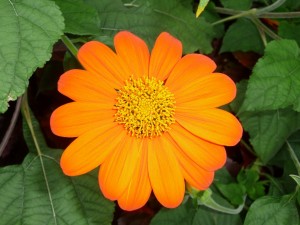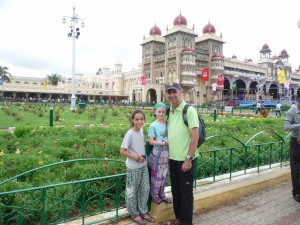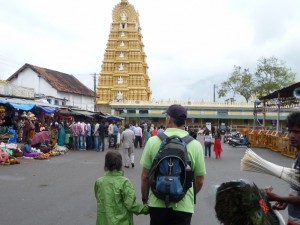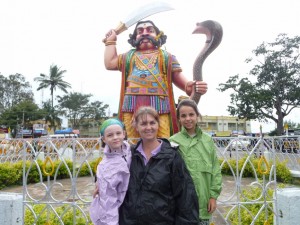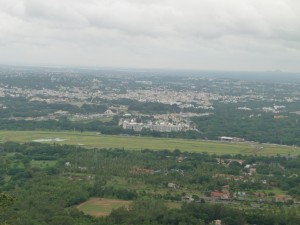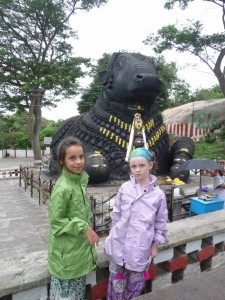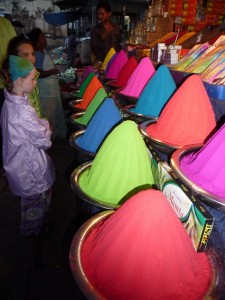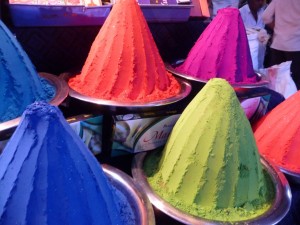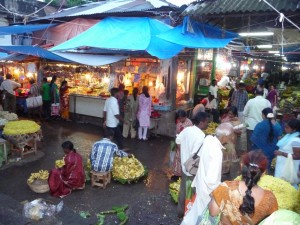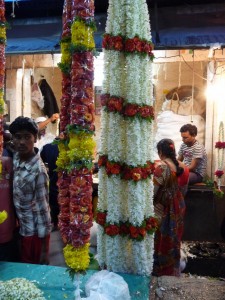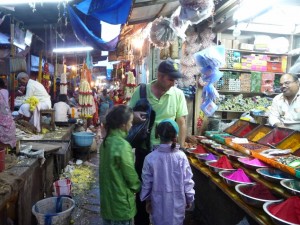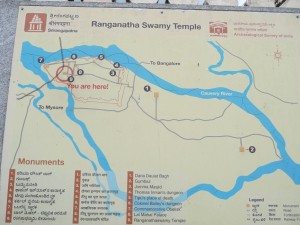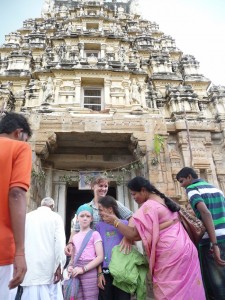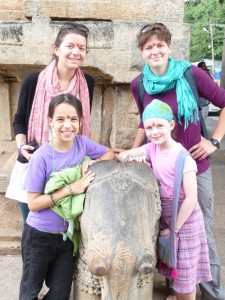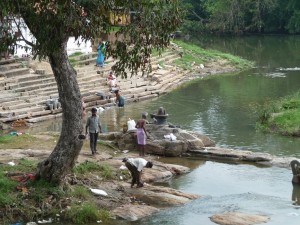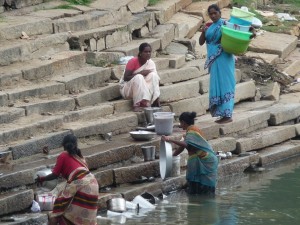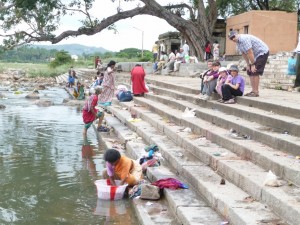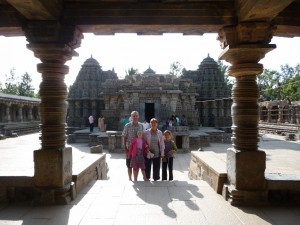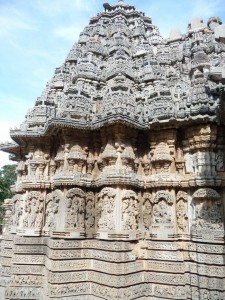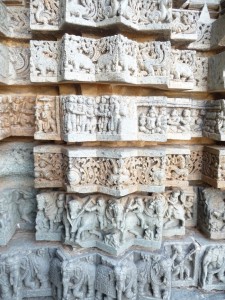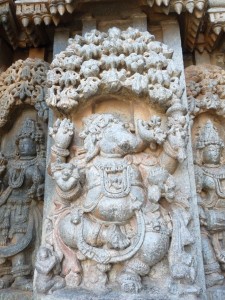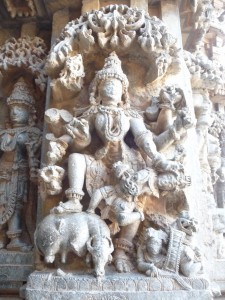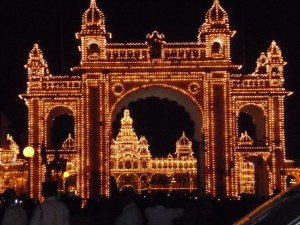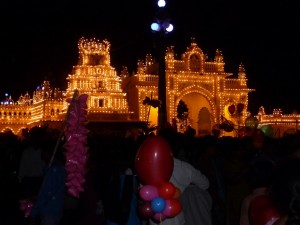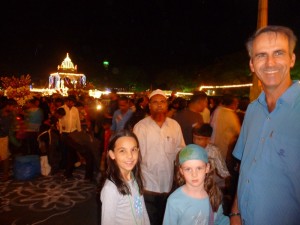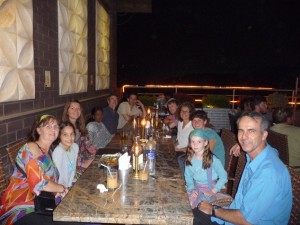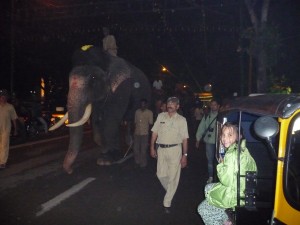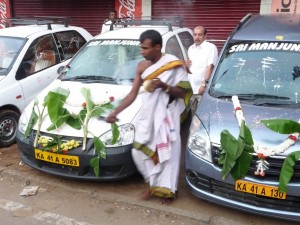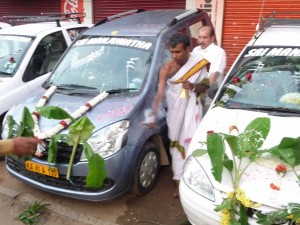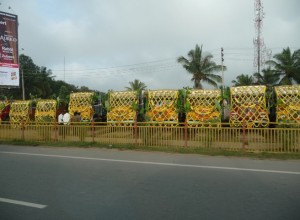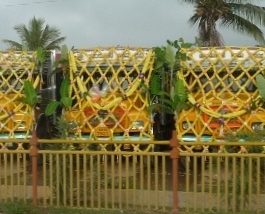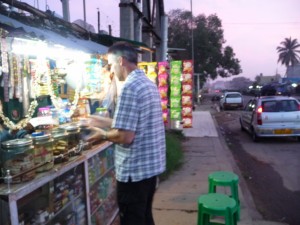Mysore, Maharaja’s and Marsala Dosas
Posted by asuasu69 on Oct 26, 2012 in India | 0 commentsAfter our restful stop in the cool highlands of Wayanad, it was time to continue inland to Mysore. As trains do not operate over the Western Ghats, it meant another bus ride to Mysore, and once through the wildlife reserve the paved road gave way to dirt and what was already bad, rapidly got worse! I am surprised the bus didn’t shake apart going over the corrugations.
As we passed over the Western Ghats, I watched in wonder at the myriad of cottage industries such as coffee plantations, teak trees and even some familiar eucalyptus trees gave way to sugar cane growing together with tomato plants on the Karnataka Plateau. Then it was cotton bushes and the many women in their colourful sari’s working in the field stuffing the freshly picked cotton into overflowing woven baskets.
Soon fields of flowers and haystacks replaced the cotton farms and in between all of it, many obviously poor villages with women chatting, men sitting around in the shade, people pumping water from the village water pumps and oxen carts slowly pulling bales of hay with drivers perched up top. Life is hard work here.
The rural scenes gradually turned to urban chaos, all the while narrowly missing the cows and veering out of the way of oncoming buses. As we approached Mysore, the biggest city we had visited in India, with the chaos came more noise and more wonderful things to see. On our way in we passed the incredible Mysore Palace; a three-storied stone structure, with marble domes and a five-storied tower. Its Indo-Saracenic architectural style that blends together Hindu, Muslim, Rajput and Gothic styles epitomise India.
I just love the immediate feeling of anticipation mixed with the enthusiasm of experiencing something new and I expressed out aloud to David, “Now I feel like we’re in India!” There was so much to take in, I don’t know where to look! After fifty plus countries, I love that I still get that feeling of excitement!
We headed to the Mysore B&B run by Steve, a Yorkshireman, who has been living in Mysore for a few years. It was a very casually run guesthouse, and when our host says, “please treat this as your home”, it was obvious he really meant it. There were plenty of great books available for us to read through, especially on Indian Gods and Goddesses. Once Steve found out we were researching these ancient myths already with the girls he enthusiastically showed us the artwork adorning the walls depicting various stories of the different Gods that he had acquired since living in India. The B&B overlooked a really pretty little park with flowers galore – a real oasis entered through the usual cattle proof gates.
The girls instantly felt at home here too and wasted no time in spreading out into the lounge room with their mini box of toys. Steve’s dog Lucy also was a drawcard and always wanted to be close to the action.
Steve has a local lady, Manjula, as housekeeper, cook and general assistant for everything. We enjoyed her cooked breakfasts (included) and sometimes spicy dinners (extra). Steve gave us some great advice about sightseeing in the Mysore area and it soon became evident that there was more to see here than we first thought.
Steve organised his auto rickshaw driver for the next afternoon to see a few sights. The first stop was the Magical Mysore Maharaja Palace which is surrounded by a large garden in the heart of the city, and is one of the largest palaces in the country. The Palace is now a museum full of treasures, paintings, jewellery, royal costumes. It is a kaleidoscope of stained glass and mirrors. We walked through the three floors passing beautiful carved doors, some that are solid silver or with mother-of-pearl inlay. The decadence of the ornately columned hall, examples of musical instruments, the armoury and white marble floors were all amazing (photography prohibited inside!). We took the audio guide (complimentary with our 200 rupee /$3.60 per adult entry), and they even provided two headsets per audio set so the girls could listen along too which was great.
Then we headed up to the Chamundi Hills for a panoramic view over Mysore and the site of the Chamundeshwari temple, the statue of the demon Mahishasura and Nandi the bull.
Before heading back home we stopped at the Devaraja Market, full of brightly coloured flowers being woven into garlands for offerings in the many temples; roses, marigolds and chrysanthamum’s being the most popular. I love walking around markets, such a timeless atmosphere. We all enjoyed seeing the vivid pyramids of powdered paints called kumkum that are mixed with water and used for social and religious markings.
Arriving the day after us at the B&B were two English girls Sophie and Lizzie, who, after a chat in the lounge room were also keen to do the sights of Srirangapatna as recommended by Steve. We also wanted to fit in a temple at Somanathapura. So after some careful planning, two rickshaws were hired for one really full day of sightseeing further afield leaving around 8.30am the next morning. We were out for the entire day and saw:
Srirangapatna – the island fortress of the legendary Tiger of Mysore, Tipu Sultan, who put up a valiant fight against British invasion.
The 9th century Ranganathaswamy Temple – a significant Hindu pilgrimage centre and from where the girls emerged sporting bindis.
Nanjangud – situated on one of the tributaries of the Cauvery River and known as the ‘Varanasi of the South’ where the pious come from far and wide to leave the ashes of the departed. We saw many small pottery urns that were easily visible on the shallow floor of the river.
Tipu Sultan’s Summer Palace – a museum devoted to Tipu Sultan and built entirely from timber.
After a quick lunch of Masala Dosa and the girls enjoying taking turns in riding in Sophie and Lizzies rickshaw, we then headed further out. 35km from Mysore is Somanathapura, once the capital of the Hoysala empire that ruled between the 10th and 14th centuries in southern India. The temple of Chennakeshava, considered one of the finest examples of Hoysala Architecture is stellar in shape. It has three amazing carved pinnacles and stands on a raised platform with the walls above the plinth carved with exquisite figures of gods and goddesses, dancing girls, musicians, gurus and all kinds of animals including elephants, lions, cows and monkeys.
Its unique design and perfect symmetry very much reminded us of the temples in Angkor Wat as they shared this complex design. We all circled the temple many times identifying the gods and goddesses. In preparation for our visit we had done another lesson the day before using the wonderful books of Steve’s, so the girls were excited to be able to identify the Gods and Goddesses, and their vehicles (the animals associated with each God).
It was a big day and we didn’t return until well after 5pm. However, Phoebe and Immi really enjoyed having Sophie and Lizzie along who spurred their interest further than what Mum and Dad ever could! On the way back Immi, Lizzie and Sophie recorded the ‘rickshaw rap’ on Immi’s iPod, a rap number about what we’d seen, Steve’s B&B complete with the authentic background noises of India (beeping). The girls love to play back and laugh. Thanks Sophie and Lizzie for entertaining them!
We were also lucky to be in Mysore for the preparation of the Dasara Festival. Dasara is the festival of Victory of Good over Bad, God over Devil, and has been observed since the 15th century and includes nine days of worship and celebration that culminate on the tenth day. The Mysore Palace is the main venue for the famous Mysore Dasara Festival. During Dasara the Palace is illuminated with close to 100,000 bulbs, and there is a real feeling of celebration with dance, music and performances. It really is a spectacle to behold.
On our second night Steve had invited all his guests out to dinner at a rooftop restaurant in town so we went a little earlier in order to walk around and soak up the atmosphere, and to see the lights. India celebrates Festivals in a way only India could – with more noise, colour and excitement than you could think was possible! The feeling of anticipation was palpable.
We also got to see the elephants practising for their march which is an integral part of the Dasara Festival final day. The elephants are highly decorated with paints and lead the procession through the city.
The Dasara celebrations kick off with pooja ceremonies (religious rituals as an offering to deities) with Durga, the warrior Goddess who contains the combined energies of all the Gods, being the principle Goddess on this occasion. Tools, implements and things used in daily life such as computers, books and vehicles are also blessed with buses, trucks and huge machines all being decorated – an amazing sight to see!
At the B&B, Steve and Manjula took delivery of a new washing machine (an unusual sight in India where washing by hand is still the norm even in middle class homes). The washing machines arrival at the B&B was timed to coincide with Dasara and it had to undergo ‘pooja’ before being put to work! Such a different world!
Mysore was certainly an unexpected pleasure and our original three nights in the city turned into four. We had a morning flight booked out of Bangalore, however there were no bus or train services which would connect us in time from Mysore. After weighing up the cost of a private car and driver directly from Mysore to Bangalore airport against the cost for a bus/train, an inconvenient one night stop in a hotle and a taxi to the airport, we decided to stay a night longer in Mysore. This option meant getting up super early and leaving Mysore at 4am for the four hour drive direct to Bangalore Airport to catch our 9.30am flight via Delhi to Udaipur which would be the start of our northern Indian adventure.
So far things had been relatively easy going… was our luck going to hold out?

